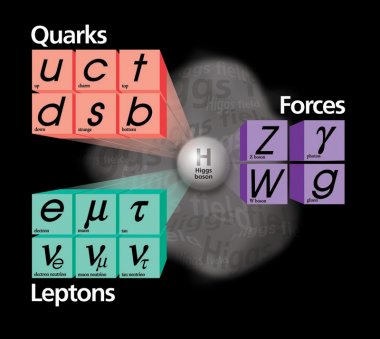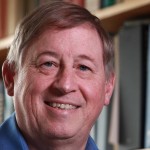 EUGENE, Ore. -- (July 4, 2012) -- Physicists on experiments at the Large Hadron Collider say that they have observed a new particle, but they remain uncertain that it is the predicted Higgs boson.
EUGENE, Ore. -- (July 4, 2012) -- Physicists on experiments at the Large Hadron Collider say that they have observed a new particle, but they remain uncertain that it is the predicted Higgs boson.
Calling their results preliminary and still under analysis, physicists at CERN in Geneva and in the United States, in a press release, said the new particle, a boson, that they've observed is in the mass region of about around 125-126 Giga electron Volts.
That mass, said University of Oregon physicist James Brau, is about 130 times the mass of a proton. The heaviest particle is the top quark, a fermion.
Brau heads the UO's efforts on the ATLAS experiment at the Large Hadron Collider (LHC) at CERN. ATLAS is one of two general-purpose experiments designed to cover the largest possible range of LHC physics.
 "This is the heaviest mass of any boson ever detected," Brau wrote in an email from Melbourne, Australia, where he and fellow UO ATLAS collaborator Eric Torrence are attending the biannual International Conference on High Energy Physics. "As far as we can tell from the first glimpse, this boson has the properties of the long sought Standard Model Higgs Boson, but we need to look more closely to determine that it is a Higgs boson and what is its true character."
"This is the heaviest mass of any boson ever detected," Brau wrote in an email from Melbourne, Australia, where he and fellow UO ATLAS collaborator Eric Torrence are attending the biannual International Conference on High Energy Physics. "As far as we can tell from the first glimpse, this boson has the properties of the long sought Standard Model Higgs Boson, but we need to look more closely to determine that it is a Higgs boson and what is its true character."
Hundreds of scientists and graduate students from U.S. institutions have roles in the search for the Higgs at the Large Hadron Collider (LHC) in Geneva. More than 1,700 people from U.S. institutions -- including 89 American universities and seven U.S. Department of Energy (DOE) national laboratories -- helped design, build and operate the LHC accelerator and its four particle detectors.
The United States, through DOE's Office of Science and the National Science Foundation, provides support for research and detector operations at the LHC and also supplies computing for the ATLAS and CMS experiments.
The UO's contingent at the ATLAS experiment comes from the Center for High Energy Physics, which is headed by Brau. Other involved faculty members are David Strom, who currently is the ATLAS trigger coordinator, Ray Frey and Torrence.
Others participants are Nick Sinev, a senior research associate, postdoctoral researchers Mansoora Shamim and Chris Potter, and graduate students Elizabeth (Liza) Brost, Elizabeth Ptacek, Andreas Reinsch and Jacob Searcy.
Strom, Shamin, Reinsch and Brost currently reside at CERN and work on the ATLAS experiment. Potter, Searcy and Ptacek previously had lived on site.
A new member will join the UO membership in the fall, when Stephanie Majewski arrives as an assistant professor. Majewski, who earned her doctorate in 2007 from Stanford University, currently is at CERN as a member of the team from Brookhaven National Laboratory.
The UO formed an Experimental High Energy Physics group in 1988 with the goal of contributing to the search and discovery of the Higgs boson. The group is part of the Center for High Energy Physics, which also includes a theoretical research group.
About the University of Oregon
The University of Oregon is among the 108 institutions chosen from 4,633 U.S. universities for top-tier designation of "Very High Research Activity" in the 2010 Carnegie Classification of Institutions of Higher Education. The UO also is one of two Pacific Northwest members of the Association of American Universities.
Media Contact: Jim Barlow, director of science and research communications, 541-346-3481, jebarlow@uoregon.edu